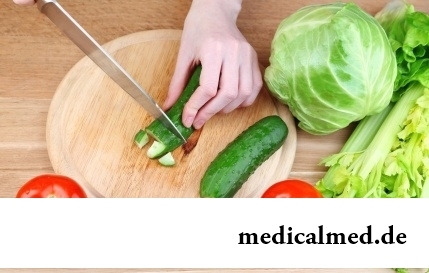





Carrots caloric content
Carrots – the garden two-year plant root crop, as a rule, orange color reaching up to 1 m in height and blossoming from June to August.
Low caloric content of carrots allows to use this vegetable as a dietary product in many diets. It is used in kitchens of the different countries in various look.
Carrot puree is used as baby food, the carrots cut by a straw and roasted in hot fan are healthier analog of French fries, and in the dehydrated view from it do powder, flakes and chips which regardless of that how many calories in carrot, have quite high energy value.
Useful properties of carrots
The majority of grades of carrots contains about 88% of water, 7% of sugar, 1% of proteins, 1% of cellulose, 1% of ashes and 0,2% of fat.
Carrots which caloric content on 100 g makes 41 kcal are rich in beta carotene which turns in a liver into vitamin A which will in turn be transformed in a retina to rhodopsin – a violet pigment necessary for night vision. Beta carotene protects eyes from a degeneration of a macula lutea and a senile cataract.
Carrots are also rich with antioxidants and minerals. Many researches confirm that vegetable reduces risk of development of cancer diseases, such as lung cancer, a mammary gland and a large intestine. Overconsumption of carrots can lead to a state at which skin becomes orange color.
Low caloric content of carrots allows to use this vegetable in various diets. A daily diet with the high content of carotinoids – the carrot diet, leads to decrease in risk of cardiovascular diseases. Carrots not only are rich in beta carotene, but also in alpha carotene and Luteinum.
Also carrots in which calories are not enough contain soluble fibers, reduce the level of cholesterol and lipoproteins of low density, increase lipoproteins of high density that helps to reduce risk of formation of blood clots and heart diseases.
Regular consumption of carrots can improve outward of skin, hair and nails, prevents risk of emergence of stomach ulcer and digestive tract.
Carrots caloric content: nutrition and energy value of a root crop
Low caloric content of carrots allows to use this root crop as a dietary product as the organism spends much bigger amount of energy for digestion of vegetable, than receives from its use.
Nutrition value and caloric content of carrots crude, at the rate on 100 g of vegetable makes:
- Carbohydrates – 9,6 g;
- Sugar – 4,7 g;
- Food fibers – 2,8 g;
- Fats – 0,24 g;
- Proteins – 0,93 g;
- Vitamin A – 835 mkg;
- Beta carotene – 8285 mkg;
- Luteinum – 256 mkg;
- Carrots caloric content – 41 kcal;
- Thiamin – 0,066 mg;
- Riboflavinum – 0,058 mg;
- Zeaxanthin – 256 mkg;
- Calcium – 33 mg;
- Potassium – 320 mg;
- Pantothenic acid – 0,273 mg;
- B6 vitamin – 0,138 mg;
- Magnesium – 12 mg;
- Folic acid – 19 mg;
- Vitamin C – 5,9 mg;
- Niacin – 0,983 mg;
- Manganese – 0,143 mg;
- Phosphorus – 35 mg;
- Sodium – 69 mg;
- Vitamin E – 0,66 mg;
- Fluorine – 3,2 mkg.
Nutrition value and caloric content of stewed carrots which ingredients for preparation are 800 g of carrots of 100 g of butter, a half-glass of water, 1 tsp of salt and sugar, at the rate on 100 g of a dish makes:
- Proteins – 0,9 g;
- Fats – 8,9 g;
- Carbohydrates – 6,4 g;
- Food fibers – 2,4 g;
- Sodium – 17,7 g;
- Caloric content of stewed carrots – 108 kcal.
Nutrition value and caloric content of salad from carrots which ingredients for preparation are: The 2nd large carrots, 3 tomatoes, 1 red pepper, 2 tbsps of sunflower oil and a third of tsp of salt at the rate on 100 g of a dish makes:
- Proteins – 0,8 g;
- Fats – 7,5 g;
- Carbohydrates – 4,7 g;
- Food fibers – 1,8 g;
- Sodium – 32,7 g;
- Caloric content of salad from carrots – 88,2 kcal.
How many calories in carrot: an easy diet for weight loss
Low caloric content of carrots allows to use this root crop in various diets as along with useful properties and weight reduction it also helps to clear an organism of slags and toxins.
The carrot diet excellently is suitable for a winter season as this vegetable perfectly keeps the useful properties throughout all winter. There are several options of a diet on carrots which caloric content is negative.
The first option of a carrot diet is expected three days during which it is possible to dump 3-3,5 kg of excess weight. For each meal it is necessary to eat 1-2 polished large carrots with lemon juice and 1 tsp of honey. In addition to grated carrot it is necessary to use one fruit at choice: garnet, orange, grapefruit, apple or kiwi. Lemon water with mint or tea without sugar acts as having a snack on such short diet.
The second option of a carrot diet is expected one week. Every morning, right after awakening, it is necessary to drink a glass of the water mixed and a half the cut lemon.
The menu of a day diet calculated on one week has the following appearance:
- 1st day: a breakfast – the cup of coffee baked in an oven carrots and two apples. An afternoon snack – 100 g of stewed carrots which caloric content makes 108 kcal. A lunch – vegetable soup, 150 g of polished carrot with 1 tbsp of 10% of sour cream. Having a snack – fresh vegetables and greens salad. A dinner – a glass of kefir;
- 2nd day: a breakfast – 2 oranges, one crude carrots and 200 g of house yogurt. An afternoon snack – 100 g of salad from carrots which caloric content makes 88,2 kcal. A lunch – a portion of chicken broth, 150 g of boiled fish and two fresh tomatoes. Having a snack – 150 g of crude carrots with lemon juice. A dinner – vegetable soup.
- 3rd day: a breakfast – a cup of coffee, a piece of the black whole-grain bread smeared with paste from a chicken liver. An afternoon snack – 100 g of a cold melon or a water-melon. A lunch – a plate of broth, 200 g of wholegrain macaroni and vegetables salad. Having a snack – is fresher than 100 g, the possessing low caloric content of carrots. A dinner – 150 g of risotto with vegetables;
- 4th day: a breakfast – a cup of coffee, 2 polished large carrots from 2 tbsps of 10% of sour cream. An afternoon snack – 100 g of salad from carrots. A lunch – a plate of vegetable borsch, 200 g of boiled beef with vegetables and greens salad. Having a snack – 150 g of crude carrots with lemon juice. A dinner – the salad from 100 g of chicken, 100 g of boiled carrots and 50 g of a cauliflower filled with 1 tsp of olive oil;
- 5th day: a breakfast – 200 g of stewed carrot and a cup of coffee without sugar. An afternoon snack – 100 g of polished carrot with lemon juice. A lunch – 150 g of boiled chicken breast and 100 g of boiled haricot. Having a snack – 100 g of carrot salad. A dinner – a glass of house yogurt;
- 6th day: a breakfast – a cup of coffee with milk, a piece of black whole-grain bread from 50 g of ham and a slice of low-fat cheese. An afternoon snack – 150 g of crude carrots with lemon juice and two apples. A lunch – a plate of beef soup, 200 g of braised beef with vegetables and greens salad. Having a snack – is fresher than 100 g, the possessing low caloric content of carrots. A dinner – 100 g of low-fat yogurt or kefir;
- 7th day: a breakfast – a glass of low-fat yogurt, 100 g of skim cheese and a cup of coffee without sugar. An afternoon snack – 100 g of polished carrot with lemon juice. A lunch – 200 g of stewed carrots with cabbage and beef and a piece of black whole-grain bread. Having a snack – 100 g the possessing low caloric content of carrots. A dinner – vegetable salad.
According to researches, the women drinking several glasses of beer or wine in a week have the increased risk to develop breast cancer.

We present to yours the TOP of the medicamentous means exerting the stimulating impact on a potentiality, i.e. on ability of a muzhcha...
Section: Articles about health
Long time antibiotics were considered as a panacea from all diseases and were appointed even at insignificant symptoms of an infection. Even now not everyone knows in what force of antibiotics how and when they should be accepted. Let's discredit 7 popular myths about such drugs...
Section: Articles about health
With age in a human body harmful substances collect. We receive them with food and water, at inhalation of the contaminated air, reception of medicines, use of household chemicals and cosmetics. A considerable part of toxins accumulates in a liver which main function is continuous purification of blood. This body begins to knock as any got littered filter, and efficiency of its work decreases....
Section: Articles about health
(Xerostomia) many people consider feeling of a xerostomia small and easily removable inconvenience. This delusion...
Section: Articles about health
From sexual contacts each person can test insufficiently strongly expressed sexual desire or lack of satisfaction from time to time. However when it happens regularly, it is an occasion to think about health. Most of people does not hurry an obrashcha...
Section: Articles about health
Ability of an organism to resist to adverse environmental factors (to impact of temperature drops, humidity and pressure, to the attacks of causative organisms, etc.) directly depends on what the person eats. Business here not only in that cells of a body received a necessary set of nutrients, vitamins and microelements. Scientists established that such components which are capable to influence negatively immune system, in connection with also are a part of foodstuff...
Section: Articles about health
The metabolism at each person proceeds in own way. However dependence between the speed of this process and disposal from superfluous in...
Section: Articles about health
Wood louse – the ordinary-looking unpretentious plant extended in all territory of our country. It quickly expands, and sometimes fills sites, bringing a lot of chagrin to gardeners. Perhaps, they would be upset less if knew that the wood louse is the prices...
Section: Articles about health
The cosmetics intended for improvement of a condition of skin, nails and hair are used by each woman. Expenses on regular acquisition of the fashionable widely advertized products of well-known companies for many become very notable and significantly burden the family budget. Meanwhile, there is a number of inexpensive pharmaceutical drugs which can quite be applied in the cosmetic purposes. At the same time the effect of their use is often more noticeable, than result of use of the most expensive...
Section: Articles about health
Statistically, at the address to doctors seven of each ten patients complain of a headache. Actually people, periodically...
Section: Articles about health
Sometimes it seems that modern society was divided into two camps: representatives of the first are sure that only the woman has to be responsible for contraception, representatives of the second, respectively, are sure that it is destiny of men. Meanwhile Dov has a question of contraception...
Section: Articles about health
The brain of the person is studied not one hundred years, but the quantity of the riddles connected with this body increases rather, than decreases. Perhaps, numerous delusions concerning a structure and functioning of a brain are explained by it, many of which arose long ago, but continue to exist and today. Such we are ready to acquaint readers with the most widespread myths....
Section: Articles about health
The majority of gynecologic diseases prove three main signs, each of which speaks about need to the visa...
Section: Articles about health
Summer in the heat. Many are going to spend vacation abroad. Travelers the tender seas, rest on beaches wait, for sightseeing, campaigns on natural and cultural reserves. But, unfortunately, on vacation also problems about health can wait for us...
Section: Articles about health
Producers of milk mixes for children assure: mixes are ideally balanced and adapted for needs of babies. If mother should raise artificially the kid owing to serious problems with health, to do nothing – it is necessary to feed with substitutes of milk. However pediatricians note that not seldom women without good reasons refuse feeding of the child a breast and pass to milk mixes. Common causes of such decision – the aspiration to leave quicker...
Section: Articles about health
Vitamin complexes belong to the most popular drugs, probably, in our country there is no person who was not hearing about a floor...
Section: Articles about health
Feeding by a breast - the integral part of ideal motherhood allowing to come into contact with the kid and to create to it healthy immunity since early years. Nevertheless, this important process in life of mother and child can be saddened laktostazy − by a delay of milts...
Section: Articles about health
Practically each person is familiar with the annoying, pulling, unscrewing pains caused by overcooling of muscles of a back. In certain cases inflammatory process is not limited to discomfort, being followed by emergence of hypostasis, consolidations, temperature increase. At the wrong treatment the acute miositis can lead to a chronic disease or aggravation of other pathologies of a back (vertebral hernia, osteochondrosis) therefore it is important to pay attention to symptoms of an illness in time and to start to...
Section: Articles about health
The immunity role in growth of the child is invaluable. The proteins-immunoglobulins produced by immune system preserve the child against diseases...
Section: Articles about health
Physical activity is necessary for normal functioning of a human body. At a lack of the movement joints cease to function, muscles atrophy, cardiovascular activity is broken and the metabolism worsens. Modern городс...
Section: Articles about health
The climax, or menopause is the normal process of the termination of genital function of the woman which is followed by serious hormonal changes in an organism. Usually the menopause begins at the age of 50-55 years, but characteristics of this process are very individual. Factors of earlier approach of a climax are irregular sex life, numerous abortions, addictions, existence of endocrine, autoimmune and gynecologic diseases, frequent stresses and excessive hobby of diets...
Section: Articles about health
All diseases from nerves – in this joke a big element of truth, are said by doctors. Constant stresses lead body to decrease in protective forces...
Section: Articles about health
Quite large number of people adheres to the principles of vegetarian food. But how to be if in a family of vegetarians there are children? Whether it is possible to eat also it the same as to parents, or after all the children's organism is not adapted for the use only раст...
Section: Articles about health
Dietary supplements (dietary supplements) for the last decades were so thoroughly included into our life that, apparently, it is already impossible to find the person who at least once did not try them. At the same time, most of our compatriots have a vague idea of what dietary supplements as they affect a human body consist of and what differ from the real medicines in. Let's try to understand these questions, and at the same time and to understand, such additives are how necessary for us....
Section: Articles about health
Among a set of the perfumery and cosmetic goods which are released today the special group is made by the means containing anti-bacterial...
Section: Articles about health
Since the moment when the child becomes a school student, his sight begins to be exposed to the strengthened loadings which are supplemented with viewing of animated films and long computer games. During this period of life of the child development not completely created bodies to a zra...
Section: Articles about health
We live during an advertizing era. Daily each person receives a solid portion of persuasive councils about what to eat to be healthy and successful. Products about which we will talk today are combined by the following circumstance: all of them are positioned as the most useful and the most suitable for inclusion in a morning meal. Unfortunately, it is not true: these 10 products do not suit for breakfasts at all....
Section: Articles about health
